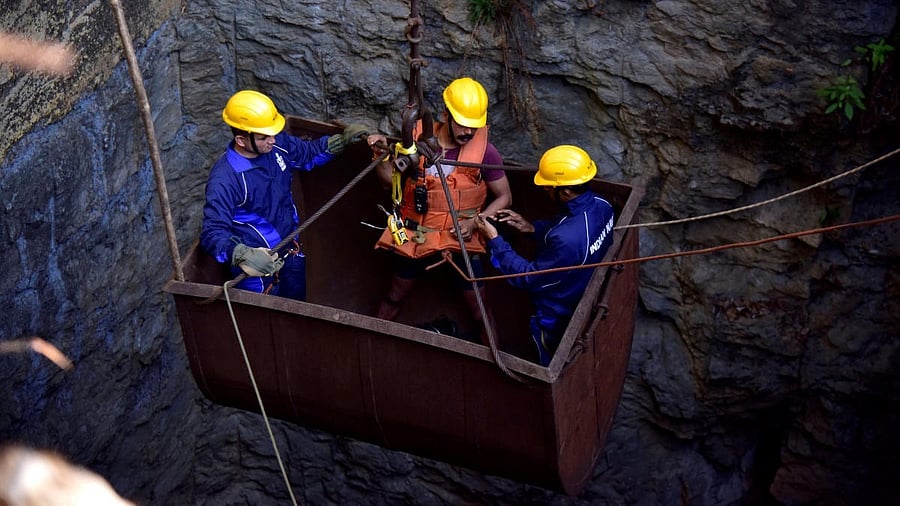
File photo showing divers using a pulley to enter a collapsed coal mine in Meghalaya.
Credit: Reuters file photo
The news of at least nine workers being trapped in a coal mine at Umrangso in Assam’s Dima Hasao district on the evening of January 6 was all too familiar. The region has witnessed numerous similar tragedies in illegal “rat hole” coal mines across Meghalaya, Nagaland, and Assam, where impoverished workers have lost their lives, often with their bodies never recovered.
At Umrangso, the bodies of four workers, including one from neighbouring Nepal, were retrieved, but five remain untraceable. The aftermath of such mishaps tends to follow a familiar pattern: cases are registered against illegal mining operations, managers and sardar of labourers are arrested, inquiries are ordered, and little changes thereafter.
In the Umrangso case, at least 11 people, mainly managers and sardars, have been arrested, and a judicial inquiry has been ordered by the BJP-led Assam government. Chief Minister Himanta Biswa Sarma also ordered the sealing of all 220 illegal coal mines detected only after the Tinkilo mine near Umrangso was flooded. Umrangso, a commercial town, is located about 30 km from Haflong, the district headquarters of Dima Hasao.
However, the chief minister remained silent on allegations by Opposition parties about the involvement of those in power within the Dima Hasao Autonomous Council, a body protected under the Sixth Schedule of the Constitution.
The council, too, is BJP-controlled. Sarma said that action would follow based on the police investigation and the judicial inquiry committee’s report.
“Since the CM has admitted that the mines are illegal, let him act against those running them,” said Jagadish Bhuyan of Asom Jatiya Parishad (AJP), a regional party opposed to the government. Umrangso is not the first such case in Assam.
Similar cases of illegal mining and deaths in “rat hole” mines have also been reported in Margherita, Ledo, and Lekhapani in eastern Assam and in Karbi Anglong, another hill district bordering Meghalaya. While Coal India Limited operates mines in the Margherita-Ledo area, and the Assam Minerals Development Authority permits scientific open-cast mining at several locations, illegal “rat hole” mining persists in remote areas, leading to frequent mishaps. “Such illegal activities cannot continue without a nexus with those in power,” Bhuyan said.
“You only talk during a mishap and forget it thereafter,” Shillong-based anti-mining activist Agnes Kharshiing responded angrily when DH contacted her for her comment a day after the Umrangso tragedy. Her anger was justified given the fact that little has changed in her state, Meghalaya, since a similar mishap at Ksan village in East Jaintia Hills district similarly killed at least 13 workers in December 2018. The incident at Ksan happened despite a ban on coal mining by the National Green Tribunal (NGT) in 2014 and later by the Supreme Court.
A few workers and sardars were arrested, and an inquiry was ordered. Most of the recommendations by an inquiry committee headed by a former judge of the Gauhati High Court, Justice BP Katakey, too have remained on paper.
Land ownership in Meghalaya: The government has little control over the land in Meghalaya, a Sixth Schedule State, where the Coal Mines Nationalisation Act, 1973 does not apply. The landowners are thus also the owners of the minerals beneath and often allow haphazard and unscientific mining.
The NGT had banned coal mining, citing adverse impact on the forests, human health, and contamination of rivers. In 2019, the NPP-led Meghalaya government, however, moved the Supreme Court and got the NGT ban vacated with the promise that only scientific mining would be allowed. “Scientific” mining by authorised miners, thus, resumed in Meghalaya last year.
Kharshiing told DH that illegal mining was still rampant in West Khasi Hills, South West Khasi Hills, East Jaintia Hills, and South Garo Hills. “There is a network with police, politicians, and coal mafias,” she alleged.
In “rat hole” mining, workers dig vertical wells inside jungles and then make narrow horizontal shafts to extract coal. Some shafts are so narrow that workers must crawl like rats, earning the mines their name. Workers, who managed to come out of the flooded well at Umrangso, told journalists that the well was 300 feet deep and had numerous horizontal shafts.
Jobs crisis: The lack of jobs and low wages in the industrially backward Northeast is another factor that drives workers to take up dangerous work in “rat hole” coal mines. While the maximum daily wage in Assam is Rs 500-Rs 600, those working in such coal mines earn between Rs 1,500 and Rs 2,000. Sardars earn more by supplying labourers, particularly from comparatively backward districts in western and northern Assam. Many workers, who had earlier migrated to Kerala and Karnataka, are also seen engaged in such coal mining. Some of the workers rescued from the coal mine in Uttarakhand in November 2023 were also from western Assam. Kharshiing said workers are even brought from neighbouring Bangladesh and Nepal for their “expertise.”
Before the mishap at Umrangso, at least 21 people died in three major mishaps in Meghalaya’s Jaintia Hills in 2018 and 2021 and in Wokha district of neighbouring Nagaland in 2024.
Meanwhile, at Umrangso, the army and several other agencies continue dewatering operations as flooding halted the search operations by the Navy and the National Disaster Response Force. But none there expects this to be the last such disaster.